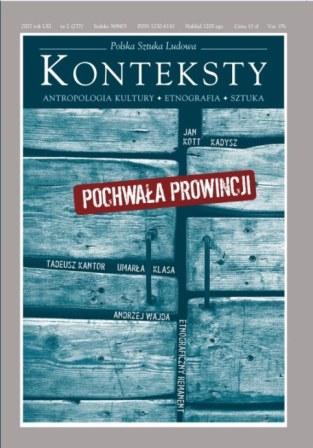Ewolucja widowisk masowych w Związku Radzieckim
(od roku 1917 do lat 30)
The Evolution of Soviet Mass-scale Spectacles (from 1917 to the 1930s)
Author(s): Katarzyna OsińskaSubject(s): Anthropology
Published by: Instytut Sztuki Polskiej Akademii Nauk
Keywords: anthropology; theatre; USSR
Summary/Abstract: The point of departure for the titular theme of mass-scale spectacles in post-revolutionary Soviet Russia (and from 1922 – the Soviet Union) are the differentiated and contradictory sources of this phenomenon. On the one hand, the latter referred to the concept of the “masses” which, according to its class interpretation, did not represent society as a whole but predominantly the proletariat, and in certain versions – exclusively the proletariat from highly industrialised factories and large cities. On the other hand, mass-scale spectacles emerged from pre-revolutionary idealistic conceptions of the renascence of culture via the rejection of individualism and a return to primary sources focused on the commune. These notions, inspired by views expounded by Nietzsche, were propagated and developed in Russia by Viacheslav Ivanov, the idea of “bogostroitelstvo”, which combined Marxism and religion (Lunacharsky, Alexandr Bogdanov, et al.) and the idea of “sobornost”, stemming from the Russian Orthodox movement and represented by, i. a. Nikolai Berdyaev. The first post-revolutionary years featured two discernible and mutually hostile tendencies in culture: the project of objectifying the proletariat, expressed in the idea of the “mass-scale theatre”, and, on the other hand, the “theatre for the masses”, according to which the masses were treated as an object and passive recipients, and art – as a tool of ideological indoctrination. The first project was developed chiefly upon the basis of the Proletcult. In a suitable sub-chapter the author recalls the polemic between Lenin and Proletcult ideologues, with special emphasis on the inner contradictions both within the Proletcult ideology and the stand represented by the Bolshevik party. A depiction of the Proletcult ideology in the domain of the theatre encompasses also its less known aspects (with reference to forgotten source material), such as the rejection of the copyright “fetish” (which rendered possible an unrestricted adaptation of the classics) and a new conception of the theatrical company: radical Proletcult theoreticians proposed a total abolition of the function of the director (who personified the old bourgeois system based on hierarchy) and his replacement by a collective. In the new theatre, as envisioned by Proletcult, the actor was to become the foremost expression of mass-scale and collective principles. The successive sub-chapters discuss assorted forms of the mass-scale theatre: amateur theatricals, the theatre in the armed forces, mass-scale performances (including the most famous Capture of the Winter Palace), communist rituals, political carnivals, as well as marches, parades and demonstrations from the 1930s. Examples of the spectacles and their descriptions come from Soviet texts (1918 – mid-1930s).
Journal: Konteksty
- Issue Year: 2008
- Issue No: 02
- Page Range: 154-175
- Page Count: 22
- Language: Polish
- Content File-PDF

